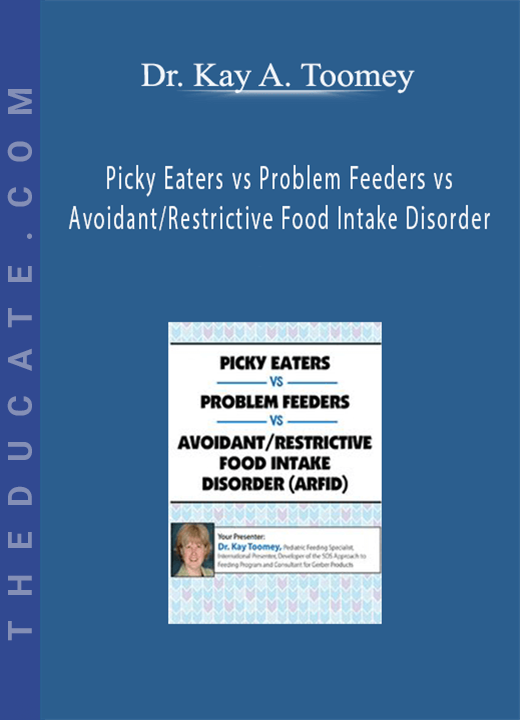Description

-
Dr. Kay A. Toomey – Picky Eaters vs Problem Feeders vs Avoidant/Restrictive Food Intake Disorder (ARFID)
- Faculty:
- Dr. Kay A. Toomey
- Duration:
- 6 Hours 29 Minutes
- Format:
- Audio and Video
- Copyright:
- Jan 16, 2020
- Food aversions
- Lack of interest in eating or food
- Avoidance based on sensory characteristics of food
- Fear of choking or other adverse consequences
- Serious medical and psychological complications consist of
- Severe malnutrition
- Growth failure
- Marked interference with psychosocial functioning
- Identify physical, motor, sensory, oral-motor, environmental, nutritional and behavior factors necessary to consider, to properly assess feeding problems.
- Delineate differential criteria for determining a child’s diagnosis as a typical eater, picky eater, problem feeder or a child with ARFID.
- Learn when to refer to a specialist for additional treatment.
- Picky eating
- Problem feeding
- ARFID
- 7 areas of human function
- How children learn to eat (or not)
- Medical/organs
- Oral-motor skills
- Sensory-motor skills
- Postural and motor skills
- Nutrition
- Learning/cognition
- Environment
- Picky eating
- Able to tolerate new foods on plate
- Decreased range or variety of foods that will eat
- Frequently eats a different set of foods than the rest of the family
- Problem feeding
- Restricted range or variety of foods
- Refuses entire categories of food textures
- Cries and “falls apart” when presented with new foods
- ARFID
- Accept a limited diet in relation to sensory features
- Food refusal is related to aversive or fear-based experiences
- Extreme pickiness; distractible and forgetful
- Systematic desensitization
- Flooding/escape extinction
- Eating disorders
- Picky eating –
- Case 1 = 2 ½ year old male with limited number of accepted foods he will eat, variable eating from one day to the next, issues staying at the table
- Case 2 = 2 ½ year old female with restricted food range, over reliance on liquids for calories and swallowing assistance
- Case 3 = 9 year, 8 month old male with lack of healthy proteins per parents, and no vegetables in his food range
- Problem feeding –
- Case 1 = 3 year, 10 month old female with a G-tube, born at 26 weeks gestation, complicated medical history
- Case 2 = 4.25 year old female born with congenital Rubella, poor weight gain, restricted food range, episodes of gagging and coughing, episodes of refusing to eat
- ARFID –
- Case 1 = 15 year old male with chronic “chok-y” sensation, significant weight loss, hospitalized in an Eating Disorders program
- Case 2 = 13 year old male with difficulties eating food at school, restricted food range per parental report, refusal to eat vegetables
- Routines and environmental supports
- Matching foods to a child’s skillset
- Reinforcement
- Management of maladaptive behaviors
- Red Flags
- Picky Eater vs Problem Feeder criteria
Description
Pediatric feeding disorders make it difficult or impossible for a child to eat, drink, or digest food normally, often compromising their health and development.
The limited intake seen in these children reflects concern such as:
Watch feeding expert, Dr. Kay Toomey, who has over 30 years of clinical experience assessing and treating children with a wide range of feeding challenges. She will show you clear guidelines to utilize the appropriate therapy approach.
Learn practical therapeutic interventions to use with children from each diagnostic group and ways to improve family meal routines and increase children’s intake of more nutritious foods
Change the lives of the children you work with…purchase this recording today!
Handouts
| Manual – Picky Eaters vs Problem Feeders vs ARFID (1.9 MB) | 115 Pages | Available after Purchase |
| Instructions for ASHA credit – Self Study (64.4 KB) | Available after Purchase | |
| Commission on Dietetic Registration (CDR) Certificate Instructions (163.1 KB) | Available after Purchase |
Outline
Prevalence of the Problem
The Complexity of Feeding/Eating
How to Complete a Comprehensive Feeding Assessment
Differential Diagnoses Criteria, Research and Limitations
Treatment Approaches – Align Treatment w/Diagnosis
Case Studies: When Assessments Go Well, and When They Don’t
Practical Feeding Strategies for Pediatric Feeding Disorder
When to Refer
Faculty

Dr. Kay A. Toomey Related seminars and products: 3
Toomey & Associates, Inc.
Dr. Kay A. Toomey, is a pediatric psychologist with over 30 years of clinical experience assessing and treating children with a wide range of feeding challenges. She developed the SOS Approach to Feeding as a family-centered program for assessing and treating children with feeding problems. Dr. Toomey helped to form The Children’s Hospital – Denver’s Pediatric Oral Feeding Clinic, as well as the Rose Medical Center’s Pediatric Feeding Center. She also acts as a consultant to Gerber Products.
Dr. Toomey co-chaired the Pediatric Therapy Services Department at Rose Medical Center prior to entering private practice. She acted as the Clinical Director for Toomey & Associates, Inc.’s Feeding Clinic for six years and SOS Feeding Solutions at STAR Institute for eight years, and speaks nationally and internationally about her approach. Dr. Toomey is currently the president of Toomey & Associates, Inc., and acts as a clinical consultant to the Feeding Clinic at STAR Institute.
Speaker Disclosures:
Financial: Kay Toomey is in private practice. She receives a consulting fee from Nestle Infant Nutrition/Gerber division. She receives a speaking fee from Education Resources, Inc.; and SPD Foundation/STAR Institute. Dr. Toomey receives a speaking honorarium from PESI, Inc.
Non-financial: Kay Toomey is a member of Feeding Matters.







10 reviews for Dr. Kay A. Toomey – Picky Eaters vs Problem Feeders vs Avoidant/Restrictive Food Intake Disorder (ARFID)
There are no reviews yet.